The high floors of the city are rising and the floors are getting higher and higher, which brings great challenges to fire rescue. The fire floor equipment on the floor is too high to quickly reach the control of the fire, and can only be allowed to ravage the fire, causing major fire accidents. In response to this problem, we have developed a dual fire-fighting drone that has a large load capacity, strong wind resistance, high throwing precision, and can fire fire extinguishers remotely in a complex fire weather environment. At the same time, it can also spray fire-extinguishing powder at close range. The double fire fighting drone is a special fire fighting drone for high-rise buildings.
It features a folding fuselage design, super-load and anti-shock design, fast access to high-rise fire scenes, high-powered cameras to observe fire, and firearms to launch firefighting drones.
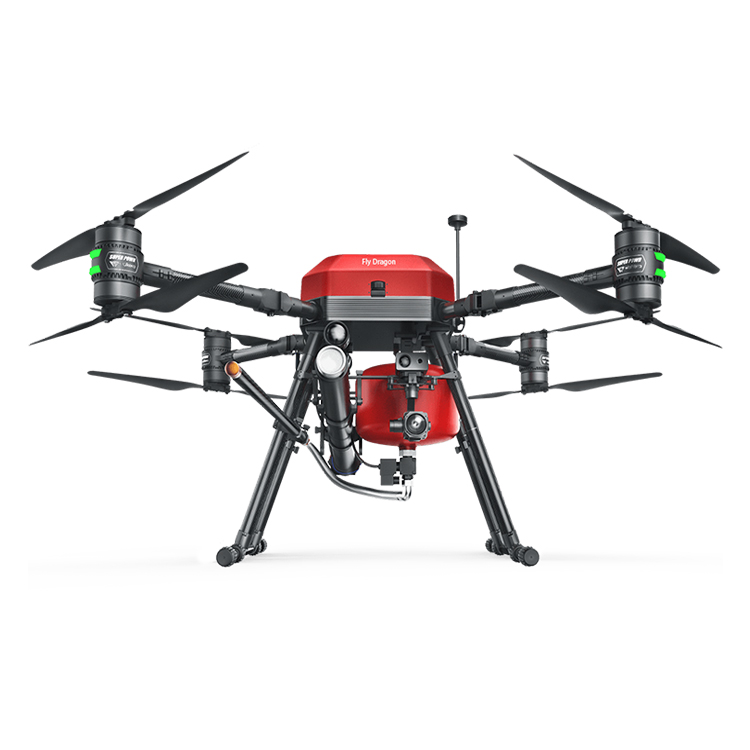
Ultra-strong load and anti-shake design, combined with high-powered scope and high frame rate camera with night vision function, high launch accuracy, capable of remotely and accurately launching fire extinguishers in complex fire weather conditions. Through the picture transmission, the aiming target point is displayed on the ground control end in real time, which greatly improves the shooting accuracy and improves the rescue efficiency.
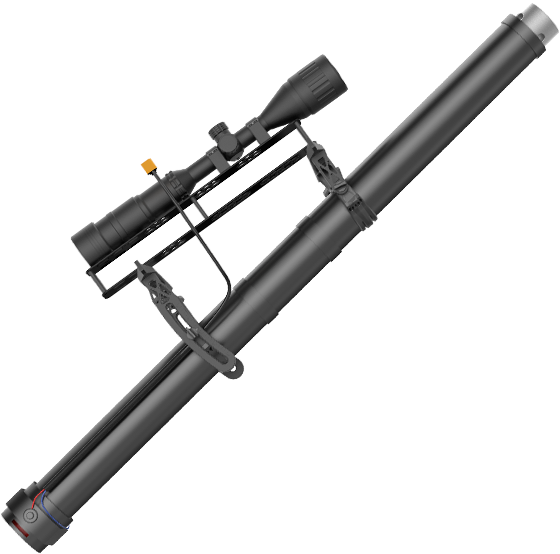
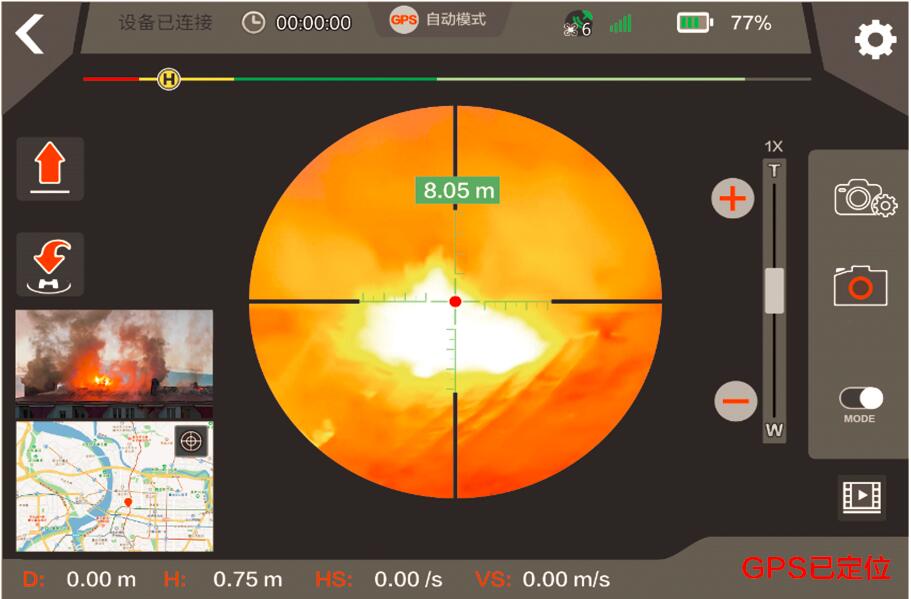
Under the fuselage of the double-fired drone, a rocket fire extinguisher and fire extinguisher are mounted. The fire power of the fire is the rocket launching power system. The effective launching distance is 40 meters, and the fire extinguishing tube is 4.8 meters in length (the shortest can bead justed to 1.2). Meter). Fire-fighting bombs and fire extinguishers are filled with special fire-extinguishing agents. Under high-floor scenes, fire source points can be accurately and effectively hit, providing high-altitude fire suppression for fire rescue.
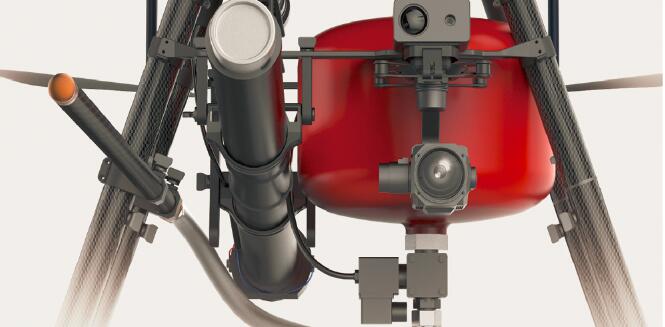
Using laser radar technology, the intelligent obstacle avoidance system is made of high-precision sensors. The laser ranging can reach 100m, and
it can recognize obstacles other than 3-15m (adjustable) in the front direction and brake deceleration to prevent accidental operation. Risk to protect your flight safety. Double protection against obstacles and ranging makes your flight safer and increases the probability of rescue.
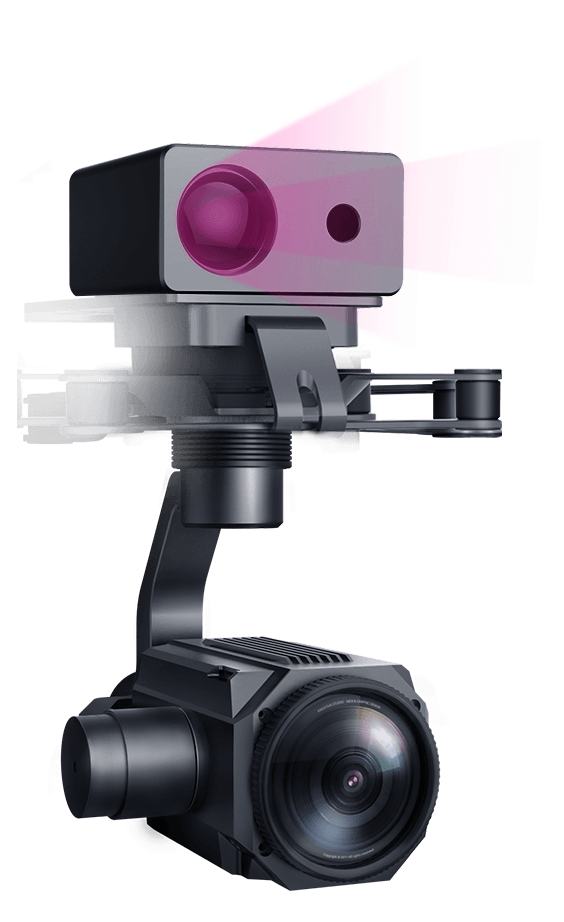
Specifications
Aircraft
| Symmetrical motor wheelbase | 1500 mm |
| Fuselage size | unfold: 1150×1150×760 mm; fold: 650×650×760 mm |
| Max. Take off weight | 45 kg |
| Propellers | Diameter X screw pitch: 30×9.9 inch; Single weight: 160 g |
| Motor | KV value: 100 rpm/V; size of the stator: 81×20 mm; Weight: 630 g |
| ESC | sustained current: 80A; battery: 6~12S; PWM input level Signal: 3V/5V compatible; Compatible frequency: 50~500 Hz |
| Battery | Voltage: 45.6V; capacity: 44000 mAh; energy: 2006.4 Wh; Type: LiHV 12S; discharge current: 25C |
| Max. Rising speed | 5 m/s |
| Max. Lowering speed | 3 m/s |
| Max. Horizontal flight speed | Sport mode: 8 m/s(windless); Attitude mode: 15 m/s(windless) |
| Max. Pitch Angle | 25° |
| Max. rotational angular velocity | pitch axis: 120 °/s, Heading axis: 120 °/s |
| Max. Bearable wind speed | 14 m/s |
| Max. Flight altitude | 5000 m |
| Max. Flight altitude(GPS) | Vertical: ±0.5 m, Level: ±1.5 m (when GPS positioning is working normally) |
| Max. endurance | 35 mins |
Gimbal and surveillance camera
| Gimbal size | 136×98×139 mm |
| Gimbal weight | 452 g |
| Gimbal input voltage | 12 V |
| Gimbal stability system | 3 axis (pitch, roll, level) |
| Gimbal angular control accuracy | Static: ±0.008°; Dynamic: ±0.02°;Anti-shake : ±0.008° |
| Gimbal controllable rotation range | pitch:-110° to +60°;level :±150°;roll :±10° |
| Gimbal control speed | pitch:30 °/s;level :30 °/s |
| Camera lens pixel | 1200 million pixels |
| Camera focus time | 7~8 seconds |
| Camera sensor | 1/2.3 SONY IMX117 CMOS |
| Camera ISO range | Video:100~3200;photo:100~1600 |
| Camera video recording resolution | 4K 30 fps |
| Camera resolution | 3840×2160 |
| Camera focal length | 6.7-134.5 mm |
| Camera zoom multiplier | 30 X optical zoom |
| Camera zoom speed | about 2.0 second |
| Horizontal camera Angle | 59.8 ° ~ 3.0 ° (wide Angle – telescopic) |
| Camera proximity | 5000mm (wide Angle – telescopic) |
| Camera video storage code stream | Max. 64 Mbps |
| Camera compression standard | H.264 / H.265 |
| Camera supports file storage format | JPG/MP4 |
| Camera supports memory card type | SD/SDHC/SDXC micro-SD card with maximum support of 128 G and transmission speed of Class10 or above or reaching uhs-1 rating |
Sighting
| Magnification | 3~9 times |
| Extent | 33 cm |
| Weight | 590 g |
| Pipe diameter | 25.4 mm |
| Objective | 40 mm |
| Exit pupil distance | 7~8 cm |
| Differentiation of line | Cross point differentiation |
| Differentiation of material | Metal Wire differentiation |
| Focus Mode | Objective lens focusing |
| Accommodation mode | Swivel lock hand mode |
| Lighting system | Red & Green double light |
| Regulating variable | one click a quarter of an inch from 100 yards away |
Lidar ranging obstacle avoidance system
| Distance measuring range | 100m |
| Range of obstacle perception | 3~15m(adjustable) |
| FOV | Level 20°;Vertical 3° |
| Survey frequency | 10kHz |
Fire extinguishing system
| Model of fire extinguisher launcher | CM60 airborne transmitter |
| Outside diameter of launcher tube | φ67 mm |
| Max. Outside diameter | φ 70mm |
| Emitter length | 1000 mm |
| Emitter weight | ≤ 1400 g |
| Fire bomb | CM60 rocket boosts ABC dry powder fire extinguishing projectile |
| Transmitter trigger voltage | 12V~24 V |
| Transmitter trigger current | ≥ 700 m A |
| Life of transmitter | ≥3 Years/100 Times |
Fire extinguishing tank
| Fire extinguishing tank material | HP295 |
| Tank weight | 8.7 kg |
| Net dry powder content | 3 Kg |
| Filling pressure | 1.2 MPa |
| Installation | Hang up fast |
| Open mode | electronic fast |
| Powder spraying pipe | Material: carbon fiber; Length: unfold4.8 m (minimum shrinkage is 1.2m) |
Fire extinguishing bomb
| Length | 995 mm |
| full weight | ≤3000 g |
| striking current | ≥ 700 mA |
| safe current | ≤150 mA |
| Initial emission velocity | ≤35 m/s |
| Max. range | ≤40 m |
| Single fire extinguishing capability | 9 m3 (Total flooding) |
| Fire extinguishing agent | Species: ABC super fine dry powder; weight:≥1100g Features: Fully sealed, waterproof,moisture-proof and non-explosive |
| Delay time for extinguishing agent injection | ≥5 s |
| Life of firebomb | 3Years |
Remote control
| Fuselage size | 65×174×62mm(L×W×H) |
| Weight | 970 g |
| Working frequency | 2.4 G |
| Working current | 1000 mA |
| Signal effective distance | about 2Km (open, no occlusion, no electromagnetic interference) |
| Video output interface | HDMI |
| Power supply mode | Built-in lithium electricity 7.4V 6000mAh LiPo 2S |
| Mobile device support | For tablets or mobile phones |
First things first, in the last eight years, over 19 percent of agencies in public safety that purchased UAVs were fire departments. That’s almost a fifth of total drones in public safety going toward firefighting. This impressive ratio definitely tells us the aerial tool is popular in the industry, but what kinds of UAVs, exactly, are being utilized? Reportedly, DJI is quite popular with fire departments, particularly the Zenmuse XT and Z30 models, as well as the Matrice 210 and Inspire 1 v2.0.
Now that we know about this industry’s evaluation, and which particular drone equipment is used routinely by firefighters, let’s take a look at the use-cases. According to Fly dragon fire fighting drone, these are the most significant areas of drone-use for this particular job.
Monitoring
Making the most informed decision means gathering as much data as possible, particularly if you’re in charge of sending boots on the ground into potential danger. It makes sense, then, to use drones to get the best available look at a fire before developing a strategy. Thermal imagery has potentially become the most useful aspect of drones in firefighting, as they can point toward the hottest and coolest areas of a building, look through smoke or other visibility-reducing elements, and thereby aid in deciding how best to approach the situation. Reportedly, drones equipped with the proper gear can also be used as floodlights during nighttime missions, further assisting those on the ground with improved visibility.
Search and Rescue
Even if you’ve only been following the drone industry peripherally, you’re aware of the basics regarding drones in search-and-rescue operations. UAVs give responders a clear bird’s-eye view regardless of time of day and provide them with immediate data while allowing them to remain safe. We recently reported on an 81-year old woman, who was lost in a field, who was found via drone. Drones are largely responsible for saving a dog’s life. What about the missing hikers in Scotland? That’s right. Drones did that.
Post-Event Assessment
Drones can capture high-quality imagery and footage throughout and post-disaster. We’ve recently seen this with the aftermath of Hurricane Harvey, where insurance companies are able to more rapidly develop estimates, or the Federal Aviation Administration realizing that UAVs could actually benefit post-disaster assessment. Even companies like Rocketmine are using UAVs to assess its operations, by analyzing the footage afterward and garnering more informative, data-driven accounts. In firefighting, drones analyze the damage, spot any survivors not visible from the ground, and utilize the recorded footage for future training or re-evaluation.
Wildfires
During the recent Los Angeles wildfires, local authorities complained about recreational drone users impeding the search-and-rescue efforts. That should never happen, and hobbyists need to learn when to keep their UAVs grounded. However, drones are a powerful tool when it comes to surveying fires growing out of control, as they can immediately re-assess which areas on the ground are becoming more dangerous, and which areas require immediate attention. It’s a tag-team operation, of sorts, between the eye in the sky and the firefighters attending to its data-driven directions.
Infographics like the one created by Dronefly put the many stories we absorb into perspective. You hear of drones being used to combat fires or rescue people and aren’t really clear on the details. It’s great to get a precise number and evaluation of funding, as well as what specific equipment is typically used, in which exact scenarios.



